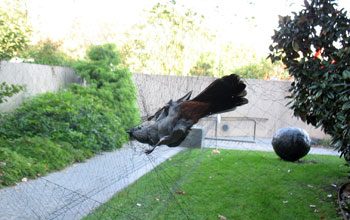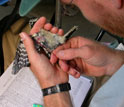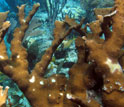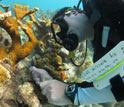News Release 13-118
Interplay of Ecology, Infectious Disease, Wildlife and Human Health Featured at Annual Conference
Scientists discuss spillover of infectious diseases among wildlife, domestic animals and people; find links between environment and human health

Birds and West Nile virus, a connection? A gray catbird caught in a research mistnet may tell.
June 28, 2013
This material is available primarily for archival purposes. Telephone numbers or other contact information may be out of date; please see current contact information at media contacts.
West Nile virus, Lyme disease and hantavirus. All are infectious diseases spreading in animals and in people. Is human interaction with the environment somehow responsible for the increase in these diseases?
The ecology and evolution of infectious diseases will be highlighted at two symposia at the Ecological Society of America's annual meeting, held from Aug. 5-9 in Minneapolis, Minn.
One symposium will address human influences on viral and bacterial diseases through alteration of landscapes and ecological processes.
Another will focus on the emerging field of eco-epidemiology, which seeks to integrate biomedical and ecological research approaches to addressing human health threats.
Much of the research presented is funded by the joint National Science Foundation- (NSF) National Institutes of Health Ecology and Evolution of Infectious Diseases (EEID) Program.
"These sessions show that basic research is critical for managing disease threats," said Sam Scheiner, NSF EEID program director. "They also showcase the need to link scientists with public health professionals."
The first symposium, on Monday, Aug. 5, will take a deeper look at the connections between human activities and infectious diseases.
Though we often think of diseases as simply being "out there" in the environment, human actions--such as feeding birds--can influence the abundance, diversity and distribution of wildlife species and thus, infectious diseases.
"New human settlements, the spread of agriculture and the increasing proximity of people, their pets and livestock to wild animals increase the probability of disease outbreaks," said session organizer Courtney Coon of the University of South Florida.
"We're interested in learning more about how urban and other environments that humans dramatically change affect the susceptibility and transmission potential of animals that are hosts or vectors of disease."
What are the key determinants of spillover of wildlife diseases to domestic animals and humans?
Why is the prevalence of pathogens in wildlife in urban areas often altered by counterparts in less developed environments?
Speakers will address these and other questions.
The second symposium, on Tuesday, Aug. 6, will continue the theme of infectious diseases, but with an eye toward integrating biomedical and ecological approaches into the investigation and control of emerging diseases.
"Environmental processes and human health are linked, and we'd like to chart a future in which ecologists and epidemiologists more routinely work in tandem to address health problems," said symposium organizer Jory Brinkerhoff of the University of Richmond.
Scientists studying human diseases may overlook possible ecological factors.
For example, most Lyme disease cases in the eastern United States happen in the North even though the black-legged tick, which transmits the bacterium, is found throughout the Eastern states.
Human life histories and interactions with the environment, researchers say, are critically important to the success of managing a mosquito-borne virus called dengue fever.
"Disease ecologists and epidemiologists address some of the same kinds of questions, yet operate largely in isolation of one another," said Brinkerhoff.
"We're bringing them together to share their approaches and study designs, and to strengthen our ability to address public health issues."
Disease Ecology in Human-Altered Landscapes: Monday, Aug. 5, 2013, 1:30 p.m.-5 p.m., 205AB, Minneapolis Convention Center.
Organizer/Moderator: Courtney Coon, University of South Florida
Co-Organizer: James Adelman, Virginia Tech
Speakers:
- Parviez Hosseini, EcoHealth Alliance
- Matthew Ferrari, Penn State University
- Marm Kilpatrick, University of California, Santa Cruz
- Raina Plowright, Penn State University
- Sonia Altizer, University of Georgia
- Becki Lawson, Zoological Society of London
Eco-Epidemiology: A Multi-Disciplinary Approach to Addressing Public Health Problems: Tuesday, Aug. 6, 2013, 1:30 p.m.-5 p.m., 205AB Minneapolis Convention Center.
Organizer/Moderator: Jory Brinkerhoff, University of Richmond
Co-Organizer: Maria Diuk-Wasser, Yale School of Public Health
Speakers:
- Maria Diuk-Wasser, Yale School of Public Health
- Daniel Salkeld, Colorado State University
- Mark Wilson, University of Michigan
- James Holland Jones, Stanford University
- Harish Padmanabha, National Center for Socio-Environmental Synthesis
- Jean Tsao, Michigan State University
-NSF-
-
Scientist Marm Kilpatrick taking a blood sample from a downy woodpecker.
Credit and Larger Version -
A nymphal blacklegged tick on leaf litter in Tennessee.
Credit and Larger Version -
Biologist Jean Tsao readies a research "tick garden" for close-up looks at ticks.
Credit and Larger Version -
Colonies of elkhorn coral are susceptible to infection by a human bacterial pathogen.
Credit and Larger Version -
Researchers study Caribbean coral reefs for clues to white pox disease.
Credit and Larger Version
Media Contacts
Cheryl Dybas, NSF, (703) 292-7734, email: cdybas@nsf.gov
Nadine Lymn, ESA, (202) 833-8773, email: nadine@esa.org
Related Websites
NSF Special Report: Ecology and Evolution of Infectious Diseases: http://www.nsf.gov/news/special_reports/ecoinf/index.jsp
NSF News Release: Controlling the Spread of Diseases Among Humans, Other Animals and the Environment: http://www.nsf.gov/news/news_summ.jsp?cntn_id=125496
NSF EEID Discovery Article Series: http://www.nsf.gov/discoveries/disc_summ.jsp?cntn_id=127103&org=NSF
ESA 2013 Annual Meeting: http://www.esa.org/minneapolis/
The U.S. National Science Foundation propels the nation forward by advancing fundamental research in all fields of science and engineering. NSF supports research and people by providing facilities, instruments and funding to support their ingenuity and sustain the U.S. as a global leader in research and innovation. With a fiscal year 2023 budget of $9.5 billion, NSF funds reach all 50 states through grants to nearly 2,000 colleges, universities and institutions. Each year, NSF receives more than 40,000 competitive proposals and makes about 11,000 new awards. Those awards include support for cooperative research with industry, Arctic and Antarctic research and operations, and U.S. participation in international scientific efforts.
Connect with us online
NSF website: nsf.gov
NSF News: nsf.gov/news
For News Media: nsf.gov/news/newsroom
Statistics: nsf.gov/statistics/
Awards database: nsf.gov/awardsearch/
Follow us on social
Twitter: twitter.com/NSF
Facebook: facebook.com/US.NSF
Instagram: instagram.com/nsfgov





